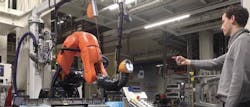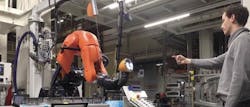Leuven, Belgium. imec, Vrije Universiteit Brussel (VUB), University of Hasselt, and five industry partners have presented a new approach to human-robot interaction in industrial environments. Introducing new adaptive control software and using gestures to improve human-machine communication, Walt, a collaborative robot (cobot), works alongside its human coworkers in a safe and flexible way. Audi Brussels, one of the project partners, is already using Walt at its production lines.
At the dawn of the Fourth Industrial Revolution, these achievements are a first step in demonstrating how this new age is poised to alter the way we live, work and relate to one another—and to robots, imec said.
Since the Third Industrial Revolution, robots are commonly used in many industries, including the automotive industry. For safety reasons, these robots operate in cages—as they are programmed to follow the exact same path over and over, no matter what kind of external force is exerted (even if it touches a human co-worker, for instance).
Facilitated by the imec.icon research program, the ClaXon project gathered a consortium of researchers and industry experts that developed new insights and technologies to improve the collaboration and interaction between people and robots in industrial production facilities. A first prerequisite for having robots work alongside human operators is the use of compliant (flexible) robots that are equipped with features such as springs to avoid swaying robot arms hurting people nearby. But this comes at the expense of robots’ accuracy. Hence, ClaXon resulted in new adaptive control software that increases the accuracy of compliant robots by 60%.
A second ClaXon research track studied new approaches for humans to communicate—and exchange knowledge—with cobots. This resulted in technology that allows human operators to demonstrate a complex task, after which that task can flexibly be performed by the cobot. Uniquely as well, the cobot recognizes the operators and receives its instructions via gestures.
“Safety and accuracy are crucial for the commercial uptake of cobots in production facilities,” underlined An Jacobs of imec and VUB. “However, the human factor is very important as well—with many social and operational questions to be answered in order to understand how cobots can best support humans in their daily routines. The ClaXon project has started to answer these questions by means of an extensive living lab user study, in which we tested various scenarios with real cobot prototypes and operators, in a real production environment.”
“In our factory we now have a fully operational cobot, working alongside our operators in a very efficient way,” said Patrick Danau, general director, Audi Brussels. “Using multimodal sensors such as heat, depth, and color cameras and electrical current sensors, the cobot observes in great detail the operators and the factory environment. Thanks to deep learning technology from Robovision, it can recognize its human coworkers and interpret gestures and movements so that operators can make quick and on-the-fly adaptations to a robot’s actions. Moreover, the cobot has been equipped with a face that is used to communicate with the operators—to acknowledge, for instance, that it has understood a given instruction.”
“Deep learning allows robots to interpret reality and select what is really important; in other words: this no longer needs to be programmed by the software engineer. We believe that this notion will fundamentally reshape the worldwide robotics industry,” added Jonathan Berte, CEO of Robovision.
“We are at the dawn of the Fourth Industrial Revolution, which is characterized by concepts such as automation, human-computer interaction, the Internet of Things, and cloud computing,” commented Luc Van den hove, president and CEO of imec. “It’s a revolution that invites companies to fundamentally rethink their products, processes, and business models to deliver greater value. Through ClaXon, Audi has demonstrated that this rethinking opens the door to product optimization and increased efficiency, while laying the foundation for truly ‘smart industries.’ Imec is at the forefront of building the technologies—and gathering the insights—that companies require to reinvent themselves and successfully ride the wave of the Fourth Industrial Revolution.”
About the Author

Rick Nelson
Contributing Editor
Rick is currently Contributing Technical Editor. He was Executive Editor for EE in 2011-2018. Previously he served on several publications, including EDN and Vision Systems Design, and has received awards for signed editorials from the American Society of Business Publication Editors. He began as a design engineer at General Electric and Litton Industries and earned a BSEE degree from Penn State.

